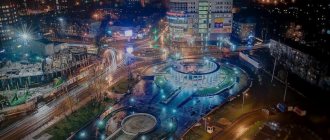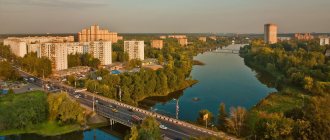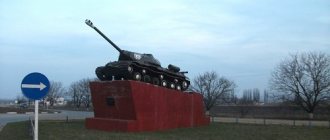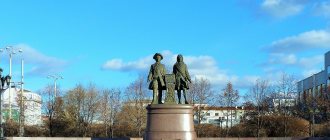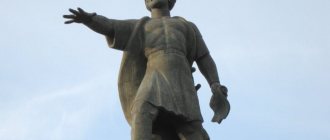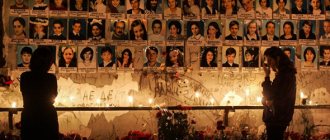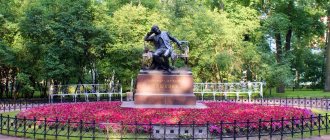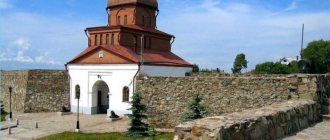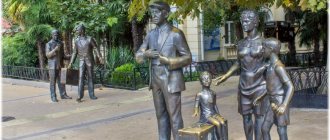According to one version, the name of Pushkino near Moscow is in no way connected with the name of the great Russian poet. In the distant past, presumably in the 14th century, a settlement arose on the Ucha River. Locals have simplified the long phrase “village on Uche” in Pouchino. Later the area began to be called Puchkino, then Pushkino.
Many local historians associate the emergence of the modern name with the name of the boyar Morkhinin. Because of his cool disposition he was called Pushka. Construction of the village began on Morkhinin's property in the 14th century. The nickname Pushka transformed into the surname Pushkin. According to some sources, the founder of the boyar family Pushkin was the ancestor of the poet A.S. Pushkin.
There is also an opinion that the settlement was named Pushkino in honor of the cannon production located nearby. In honor of this historical fact, a cannon monument was erected at the entrance to the city in 2010.
Pushkino was given city status in the mid-20th century. People come here to admire the quiet nature of the Moscow region. Tourists visit ancient churches and noble estates where Russian celebrities lived and vacationed: V. Mayakovsky, F. I. Tyutchev, K. S. Stanislavsky, A. P. Chekhov, etc.
Museums, estates and factories: the most interesting things in the Moscow region that surround Pushkino
Historical sites and museums
Water tower
Address: Vokzalnaya st., 2
The water tower was erected in 1903 to supply water to steam locomotives traveling to Sergiev Posad. The height of the tower is 20 m. After the electrification of rolling stock, it lost its original value.
The tower has turned into a city landmark, shaping the appearance of the station square. At the beginning of this century, the water pumping structure was restored.
Pushkin Museum of Local Lore
Address: Moskovsky Prospekt, 35A Telephone: Opening hours: 10.00-18.00, closed Sun, Mon Ticket price: 50 rub. Website: https://www.pushkino-museum.ru/
An exhibition of paintings and objects telling about the life of the local population opened in 1962.
The museum's exposition is located in an architectural monument of Russian architecture of the first half of the 19th century. The collected exhibits tell the history of Pushkino, starting with the Slavic tribes.
Dozens of museum sections are dedicated to archaeological finds discovered near Pushkino, local nature and culture. The museum exhibits works by the artist Evgeny Kamzolkin, architectural sketches by Vladimir Maksimov, etc.
Forest Seed Museum
Address: Nadsonovskaya, 13
The museum operates on the basis of a forest seed station and the Forest Science Center. The museum's collection includes hundreds of types of forest seeds. Museum workers will talk about the peculiarities of growing forest plants and the nature of the Moscow region.
Specialists in the field of botany can consult with professionals and receive practical advice on growing and cultivating forest crops.
Museum of Carpentry Tools
Address: st. Oranzhereynaya, 28A Opening hours: 11.00-17.00 by prior arrangement Telephone: Ticket price: 500 rub. Website: https://museumtools.ru/
The museum contains thousands of carpentry tools used in different countries of the world. Here are the tools of furniture makers, cabinet makers, musical instrument makers, shipwrights, shoemakers, etc.
The collection was collected over 32 years.
Pushkin Art Gallery Art-Licor
Address: st. 50 years of Komsomol, 1 Opening hours: 11:00-19:00, closed on Monday Telephone: Website: https://www.artlikor.com/
At the city's largest cultural venue there is a jazz club, Philharmonic concerts are held, members of a film club meet, and a framing workshop has been created.
The art gallery exhibits paintings and photographs of different genres, styles and directions. In addition to classical works, graffiti and street art are presented.
Dacha-museum of the poet Vladimir Mayakovsky
Address: Akulova Gora, 7 Opening hours: 12.00-18.00, closed on Monday Telephone:
V. Mayakovsky rented a dacha on Shark Mountain in 1928-1930. During his summer stay here, Mayakovsky created several chapters of the poem “Good” and a number of famous poems.
The museum opened in 1969. At the end of the last century, the building also housed a library. As a result of the fire, the dacha-museum was completely destroyed and turned into a garbage dump for decades.
At the beginning of this century, thanks to the work and enthusiasm of the local priest Andrei Dudarev, the two-story house was rebuilt. His project replicates the building lost in the fire. The museum has several original exhibits: a copper samovar that survived the fire, and the poet’s death mask.
In front of the entrance to the museum there is a sculpture of Mayakovsky. Enthusiasts have collected documents telling about the work and life of the poet. The museum hosts creative literary evenings.
Pushkino: what cannon is the city named after and how did it help the forests that burned in the summer of 2010
We continue the series “Small Towns of Russia” and today we will go to Pushkino, Moscow region.
This is the center of Russian forest science. 7 large enterprises of the city are associated with forestry. Tons of seeds of valuable coniferous species are stored there. It was from there that seeds were taken to restore forests near Moscow after the fires of 2010. Also in the city, local history buffs are engaged in the reconstruction of tanks. Moscow is surrounded by literary cities. In the southern direction - Chekhov, in the northern direction - Pushkino. True, unlike Pushkin of St. Petersburg, the city near Moscow is named not in honor of the great poet, but in honor of his ancestor, boyar Grigory Morkhinin. These lands belonged to him in the 14th century, and his nickname was Cannon because of his loud voice and strength. This is where the name of the city came from. The monument to the vociferous boyar stands right at the entrance, but a separate sculpture was not dedicated to his famous descendant.
In the city center on Sovetskaya Square, Pushkin sits next to Krylov. There are no more monuments to the poet in the city. But the central Pushkin streets were named after other writers. The first rehearsals of Chekhov’s “The Seagull” took place here, and Prishvin, Paustovsky and Mayakovsky vacationed at their summer dachas. Today, the literary glory of the town near Moscow is not often remembered. For 80 years, Pushkino has been known as the center of Russian forest science.
“Where we see red dots, it means things are bad there. Where there are green ones, things are relatively normal. Where there are yellow ones, you need to pay attention. Those. This is the effect of a traffic light throughout the Russian Federation,” says Vladimir Soldatov, director of the FBU Roslesozashchita.
The Russian Forest Protection Center is engaged in so-called forest prevention. Throughout the country, the condition of trees is monitored, pest infestations are predicted, and the likelihood of fires is assessed. The data is sent to the central office in Pushkin, and from here recommendations are sent to regional authorities on what measures to take to save the forest.
“This, in my opinion, is one of the most important laboratories, the laboratory of phytopathology. Phytopathology is the science of fungal diseases. Just imagine how many mushrooms there are, a sprout comes out and then the mushrooms attack it. Therefore, we give recommendations on how to cope with this or that mushroom,” explains Vladimir Soldatov.
In case the forests cannot be saved, gold reserves are kept in the center. 12 tons of seeds of especially valuable conifers are kept at a temperature of -18 degrees and used only in emergency situations. From here they took seeds to restore forests near Moscow after the fires of 2010.
Despite his love for scary machines, Pavel also sees the meaning of life in preserving the forest. On this amphibian he set a world record - in 23 days he and his friends traveled from Pushkino to the Kola Peninsula. The newfound popularity is used for a good cause - it helps to carry out environmental campaigns.
“Somehow I want to push the ideas of creation into the world, but until you are noticed, the ideas of creation will not be pushed, so we will become famous, recognizable and we will push good ideas into life,” says Pavel Zavgorodniy, extreme sportsman.
This armored car took part in parades on Red Square in the 80s, and three months ago, under the leadership of Pavel, it sailed across the Barents Sea and the Arctic Ocean. It turned out that the car is no less suitable for travel than for military operations. During the entire trip to the Kola Peninsula, the amphibian, unlike other SUVs in the team, never failed. In water, the car reaches speeds of up to 10 km per hour. For this, everything is provided here: an echo sounder for determining the depth, a navigator and a radio with a marine range.
“Sleeping in this car is a real thing, I lived all 23 days in it, I have a small bed in the back, which is very comfortable for me to sleep on,” says Pavel Zavgorodniy. Sergei does not drive military equipment, he restores it. Together with his assistants, he assembles tanks from a pile of scrap metal. Over the course of 8 years, he restored 10 cars.
“This is part of our new tank, we will have a 34. Released in 1942. Here is the tower in 1942, Nizhny Novgorod. This will be such an interesting exhibit, because there is a 76 mm cannon,” says Sergei Chibineev, a collector, “But this, too, was originally a pile of metal. Yes, these were the pieces that were put in order. You can even see the welded seams, how it was assembled.”
Sergei collects not only tanks, but also military items, posters and portraits. He opened a whole museum on his site. The hobby began in childhood: at first he collected toy soldiers, now he collects the national uniforms of the countries that participated in the Second World War. You won’t see such uniforms of a Hungarian soldier in every Russian museum.
“Probably, there are three categories of people: someone lives in the future, someone in the present. And I am one of those who remained somewhere in the past. Everything is connected with this,” shares Sergei Chibineev.
Sergei is the exception rather than the rule.
In Pushkino people do not live in the past. Young families come here to build a future. The apartments are cheaper than in Moscow, it’s not far from the capital - all the work is there. Due to active development, almost nothing remains of the corner that Prishvin and Mayakovsky loved. But few people care about this. The new life dictates its own laws, and looking back is not accepted. The artist Evgeny Kamzolkin lived on Pisarevskaya Street in Pushkino. In 1918, he created the “Hammer and Sickle” emblem, one of the main and world-famous state symbols of the Soviet Union.
Churches and Temples
St. Nicholas Church
Address: Yaroslavskoye sh., 34 Phone: Website: https://www.nikolskijhram.ru/
Through Pushkino, pilgrims went to venerate the relics of St. Sergius of Radonezh. The house monastery was erected for the recreation of believers, and a metropolitan courtyard was equipped with it. The stone church was built in the 17th century. on the site of a wooden church lost in a fire.
Two hundred years later, chapels were added to the church. Before the Second World War, the temple was looted and closed. Ancient paintings were lost, bells were broken, ancient icons were destroyed. It is equipped with a warehouse.
St. Nicholas Church was returned to the church community in 1947. The believers restored the monastery on their own. In 2007, a bell tower was erected on the building. Divine services are held in the church, and a Sunday school is open.
Church of the Bogolyubskaya Icon of the Mother of God
Address: Bogolyubskaya st., 20 Telephone: The temple is open: from 6.30 to 21.30 Website: https://bogolubhram.ru/
The church was erected at the beginning of the 20th century. with donations from timber merchant Sharikov.
The walls of the temple “remember” the voice of the great F.I. Chaliapin. He sang the glory of God before the altar during his service at the Private Russian Opera of Savva Mamontov.
In addition to the stone building, the temple complex included a wooden church and a chapel over a holy spring. During the persecution of clergy, the wooden monastery housed a dormitory. As a result of the fire, it was lost forever. The holy spring was filled with garbage, and garages were built on the site of the old cemetery.
The praying church, closed in 1936, reopened its doors to believers in 1997. Since 1993, restoration work has been underway there, which continues to this day.
Church of the Savior Not Made by Hands
Address: st. Lermontovskaya, 20 Phone: Website: https://www.spgreb.ru/
The temple was erected in honor of the reign of the Romanov dynasty at the beginning of the 20th century. After the revolution, services there ceased.
By the time the monastery was transferred to believers, at the end of the 20th century, the church was destroyed. It took more than 10 years to restore it. At this time, services were held. A bell tower with 15 bells was erected on the renovated building, and carved wooden icon cases were made.
10 years earlier, a wooden church was built in honor of the Grebnevskaya icon. Both buildings were located on the church square. The wooden monastery was decorated with a bell tower. The ringing of seven bells could be heard from it. After the revolution, the rector of the temple was subjected to repression and died in exile. The wooden church was partially ruined and destroyed in 1938. The temple in honor of the Grebnevskaya icon was returned to believers in 1992. The bell tower was restored and a carved iconostasis was made. In 2007, there was a fire in a wooden building. The monastery, which survived times of hard times, burned down.
Believers perceived the Icon of Our Lady of Grebnevskaya, found among the fire, as a miracle. The icon has been known since the time of Prince Dmitry Donskoy. It went to the great Russian commander from the residents of the city of Grebny after the defeat of the troops of the Golden Horde of Mamai in 1380. Believers endow the icon with miraculous qualities and worship it. Documents indicate that the Orthodox shrine survived several fires.
Today, the Icon of the Grebnevskaya Mother of God is kept in the Church of the Savior Not Made by Hands. The Church of the Savior Not Made by Hands is currently being restored. Services are held there. A monastery is also being built in honor of the Grebnevskaya Icon. Its appearance replicates the wooden structure that was lost in the fire, but is being built from stone.
Ten years ago, a monument to the boyar Pushka was erected at the entrance to Pushkino
This event then became one of the first in a series of events dedicated to the celebration of City Day - the 85th anniversary. Under the festive ringing of bells and the rejoicing of the guests, Viktor Lisin, who at that time was the head of the Pushkin municipal district and the city of Pushkino, removed the veil that was hiding the monument, and a majestic monument 3.2 meters high, made by the sculptor Igor Gorbaty and cast at the Noginsk foundry, was revealed to the eyes of those gathered. mechanical plant.
Who is Pushka, or Disputes around the toponymy of the city
In many publications that appeared in the media shortly after the opening of the monument, Grigory Morkhinin, nicknamed Pushka, was called the founder of the city and the ancestor of the famous poet Alexander Pushkin. The same information follows from the text of the plaque installed on the monument itself: “Grigory Alexandrovich Pushka (Morkhinin). Founder of the village of Pushkino in 1499. Ancestor and founder of the family tree of the great Russian poet A.S. Pushkin.”
However, many expressed disagreement with this statement, and this version of the origin of the city’s name is considered as an alternative.
“There is no absolutely accurate answer to the origin of the toponym “Pushkino”. Perhaps the village got its name from Grigory Aleksandrovich Morkhinin, who bore the nickname “Pushka,” wrote Boris Vasnev, chairman of the Pushkinsky district public organization of the Union of Local Historians of Russia, in a local newspaper that was published right on City Day.
“It is assumed that Grigory Alexandrovich is a descendant of one of the ascetics of Alexander Nevsky - Gavrila Oleksich. Gavrila's son Ivan, nicknamed Morkhinya, lived in Tver. Morkhini's son Alexander went to serve in Moscow with Prince Ivan III. His son Gregory received the nickname Cannon. Subsequent descendants of Gregory began to be called Pushkins (according to S. B. Veselovsky). However, there is no documentary information about the land holdings of the Pushkins in our region,” explained the chairman of the local history organization in his publication in 2010.
On the holy road of the Trinity tract...
The opening of the monument was attended by old-timers, honorary citizens of the city, government officials, including Konstantin Sedov, who in 2010 served as vice-governor of the Moscow region. He addressed the guests of the event with a solemn speech: “Dear Pushkin residents, your city is famous for its people who have made a great contribution to the development of both the food and chemical industries, as well as serious projects of a national scale, such as the development of forestry and the agro-industrial complex. We are proud of you, respect you and want us all to do one thing together for the benefit of the prosperity of our Moscow region and Russia as a whole.”
Viktor Lisin also addressed the residents: “It is symbolic that the monument was erected on the holy road of the Trinity Highway, which leads to the center of Russian spirituality, to the Trinity-Sergius Lavra, to the wonderful ancient Russian cities - Rostov the Great, Pereslavl-Zalessky. People have lived here for a long time and did a lot to make Pushkino a fertile place. By opening this monument, we are stretching a bridge from the past to the future - we are returning to the glorious history of our ancestors, and we have the right to be proud of this. Our task is to continue traditions. Today’s event begins a series of good deeds for the benefit of our city...”
City Day in 2010 was not limited to the opening of the Cannon monument. The two-day festive program dedicated to the anniversary was eventful. One of the central events then was the “We remember everyone by name...” rally at the “Grieving Mother” memorial. Afterwards, all participants lined up in columns went to Sovetskaya Square, where a large festive concert took place.
Should have stood in the park
On the day of the opening of the monument, volleys of ancient cannons, recreated by members of the military-patriotic reconstruction club “Servant”, announced that from now on a new page had appeared in the historical chronicle of Pushkin’s land - at that time, local authorities hoped that the monument to Grigory Morkhinin would organically fit into the city panorama and will become one of the symbols of modern Pushkino. However, almost immediately many were surprised by the pedestal, incommensurate with the height of the figure itself, which blocked the greatness of the boyar.
This is how the author of the sculpture, Igor Gorbaty, recalls this creation:
“It was not our creative luck. I think many people ask why the monument is so small. Initially, this sculpture was planned to be placed somewhere in the park! However, there was leapfrog and uncertainty with the architectural project, the new chief architect did not have time to explain the task, in general, we did it at random. I, my wife Oksana and my friend worked in a hurry, with enthusiasm, for two months we sculpted and made the mold...”
At the same time, many guests of the city, sharing their impressions on thematic forums, note that the location of the monument does not allow one to examine the sculpture up close and read the inscription on the pedestal. “We looked while passing, because it was not possible to stop and approach - the monument is located in the center of a roundabout with very active traffic,” a user of the site autotravel.ru shares his opinion.
Nevertheless, the monument is a kind of landmark when entering the city and, arousing interest, encourages once again to delve into the history of Pushkino.
I'll turn the calendar over and it's September 3rd again.
The opening of the monument to Grigory Morkhinin took place on September 3, 2010. And shortly before this day, the city was literally drowned in smoke. “The area and the city are engulfed in smoke, here and there you come across sensible people wearing bandages or holding wet handkerchiefs to their noses and mouths,” now leafing through newspaper reports for August-September 2010, you involuntarily remember that even ten years ago masks were in trend, but the reason was still different: “The suffocating scourge is brought by the wind from those places where the fire is raging or the dead wood is quietly smoldering, waiting in the wings...”. The summer of 2010 received the status of the hottest in the history of meteorological observations in the Moscow region: the air temperature did not fall below 30 degrees for 33 days in a row, while there was no rain for almost two months. These anomalies contributed to the outbreak of a large number of natural fires throughout the Central Federal District; stuffiness and smog reigned in Pushkino, although local media reported that there were no dangerous fires in the region.
But it was on September 3, 2010 that it rained in Pushkino in the morning, then stopped as soon as the ceremony began. With the first sounds of ancient music performed by the guslar ensemble of the Music College named after. S. Prokofiev and the wind died down. The sun came out. True, not for long - just long enough to have time to complete the solemn event.
Olga SOLOVIOVA Photo by Nikolai ILNITSKY, Anatoly SHISHKIN, Igor GORBATY yandex.ru
Source:
https://inpushkino.ru/novosti/v-gorodskom-okruge/desyat-let-nazad-na-vezde-v-pushkino-byl-ustanovlen-pamyatnik-boyarinu-pushke
Attractions in the surrounding area
Estate "Maltse-Brodovo"
Coordinates: 55.957797, 37.864282 How to get there: 10 km from Pushkino towards Korolev Address: Central St., 4, Lesnye Polyany
The manor complex was built in the 17th-18th centuries. industrialist N.P. Saltykov. To the central house in the 19th century. Various outbuildings were added.
Maltse-Brodovo went down in history because in 1918 V. I. Lenin spent the summer there. A memorial plaque on the house commemorates this event. Revolutionary V.D. Bonch-Bruevich, who later became the first director of a state farm near Moscow, came to Lenin. The state farm was organized in Lesnaya Polyana. The estate was used as an administrative state farm building. On the second floor there was a museum, which housed an exhibition telling about V. Lenin’s stay in Lesnye Polyany and the history of the state farm.
In the 80s there was a fire in the house. Today, the building and the park complex around it are in need of restoration. The Maltse-Brodovo estate was abandoned and looted.
Museum-estate of Stanislavsky "Lyubimovka"
Coordinates: 55.958570, 37.843228 How to get there: 9 km from the city of Pushkino towards the city of Korolev along the E 115 highway Address: s. Tarasovka, Lyubimovka village, Moscow region. Website: https://www.stanislavskyfestival.ru/kopiya-lyubimovka
The manor complex was built in the classicist style at the turn of the 18th-19th centuries.
During the Patriotic War of 1812, the Cossacks defended the estate. Napoleonic troops could not capture it. Initially, the estate was part of the estate of Princess A.L. Trubetskoy. The estate passed through different owners several times.
At the beginning of the 20th century. A.P. Chekhov visited Lyubimovka. Holidays at the dacha inspired the writer to create the play “The Cherry Orchard.” The places described in the play exactly coincide with the local beauty. F.I. Chaliapin came here for the summer.
K. Stanislavsky (Alekseev) spent his teenage years in Lyubimovka. He created the Alekseevsky Theater Club - a home amateur theater. On his stage, the professional development of the great Russian theater director and teacher took place.
After the revolution, Lyubimovka housed an orphanage, a hospital, and residential apartments for plant workers.
In 1996, the landmark was transferred to the K. S. Stanislavsky Foundation, which is engaged in the restoration of the estate complex. The complex includes a central estate, wooden buildings from the 19th century, a theater wing and pavilion, and a park.
Museum-reserve "Muranovo Estate named after F.I. Tyutchev"
Coordinates: 56.178345, 37.902745 How to get there: 30 km from Pushkino along the E115 highway (Yaroslavskoe highway) Address: Muranovo, Moscow region. Phone: +7 (496) 531-8180 Opening hours: 10.00-18.00, closed on Monday Ticket price: 50 rub. Website: https://muranovo-museum.ru/ru/
The main buildings of the estate complex were built at the turn of the 19th-20th centuries. The house, built in the mid-19th century, has been preserved. according to the drawings of the poet E. A. Baratynsky. He was involved in the literary and social life of Russian society of that period. The poet has amassed a collection of glassware, paintings, rare books and historical documents.
The museum exhibits authentic items that surrounded the family of the last owners of the estate - the Tyutchevs. The collection includes: paintings by European and Russian artists, rare porcelain, antique furniture, etc. The museum, opened in the first years after the revolution, was headed by the descendants of the poet N. I. Tyutchev. The estate was not ruined and destroyed because of V.I. Lenin’s love for Tyutchev’s work. The poet's descendants collected exhibits related to the life of their ancestors with special trepidation. Thanks to them, the monument of Russian noble culture has been preserved in its original form to this day.
The estate complex includes a park in which the family temple of the Putyat-Tyutchev family, an outbuilding with a summer kitchen and several outbuildings have been preserved.
Today, thematic creative evenings for literature lovers and various holidays are held on the territory of the museum complex.
If you have not yet chosen where you will live and want to save money when booking, we recommend using the RoomGuru service. Firstly, it contains hotels, apartments and guest houses from many different booking systems, so you won’t miss out on a worthwhile option. Secondly, you can immediately compare prices for one place in different services and book where it is cheaper (this is not always Booking!).
There are several common versions of the origin of the name of the city of Pushkino. According to one of them, in the second half of the 14th century, when the area along the Ucha River was owned by the boyar Grigory Aleksandrovich Morkhinin, nicknamed Pushka, the ancestor of the poet Alexander Sergeevich Pushkin. On September 3, 2010, a monument to Cannon was erected at the entrance to the city. There is also a version that the city was originally named after the Ucha River - “Pouchka”. Then the name turned into “Pushka” and then into “Pushkino”.
Historian S. B. Veselovsky points out: “According to the acts it is known that at the end of the 15th century it belonged as “ancient” to the metropolitans of all Rus', and after the establishment of the patriarchate it became the patrimonial fiefdom of the patriarchs. How and when it came to the Metropolitan House is unknown. It is possible that it was acquired in the third quarter of the 14th century. Metropolitan Alexei directly from Gregory Pushka, but the possibility is not excluded that it was alienated by one of the numerous descendants of Gregory Pushka in the 15th century.”
The first documentary mention of the village of Pushkino dates back to 1499 (“the scribal book of Prince V.I. Golenin for the metropolitan village of Pushkino, Moscow district”). The village was located on the oldest trade road in North-Eastern Rus' on the way to Pereslavl, Yaroslavl, Vologda, which contributed to the growth of its population and the high prosperity of its residents.
In the 2nd half of the 18th century, the weaving industry began to develop: the production of woolen cloth, karazei, sashes, and silk scarves. In the 1st half of the 19th century in the village. At this time, a copper plant and a wool weaving factory were opened in Pushkino, equipped with one of the first mechanical machines in the Moscow district. By the end of the 19th century, the village had turned into a factory center.
In 1867, dacha construction began. In 1868, a zemstvo school was opened for children from 8 to 14 years old. In 1890, a library was opened with funds from Armand.
In 1880, a park was laid out not far from the station, which became a favorite vacation spot for Pushkin’s summer residents. In 1896, with funds from the Yakor insurance company, a summer theater was built in the park, but it burned down in the summer of 1993.
According to the directory of 1890, 1,164 people lived in the village of Pushkino, which was then part of the Mytishchi volost of the Moscow district of the Moscow province, and in 1899 there were already 1,560 people living. According to the boundaries of settlements of that time, the village of Pushkino was located 27 kilometers from Moscow and one and a half kilometers from the Pushkino station of the Moscow-Yaroslavl-Arkhangelsk Railway. From the station to the Pushkino station it is 30 kilometers. At that time, in Pushkin there was a police officer’s apartment, a zemstvo school, a school at the Armand factory and an almshouse.
In the 1912 directory, two different settlements are indicated on the site of the modern city:
- the village of Pushkino with 233 yards, located 2.7 km from the Pushkino station. In the village there were apartments for 2 police officers, a zemstvo school, the Armand factory, a hospital at the factory and a pharmacy, a parochial school, a consumer shop, a free fire brigade, a state-owned wine shop, a 2nd category tavern, a 3rd category tavern, a Rensky cellar, two beer taverns.
- The dacha place “Pushkino”, located in close proximity to the Pushkino railway station, is separately indicated, without indicating the number of houses. In the dacha there was an apartment for the bailiff of the 4th camp and the mounted police guard and a parochial school. In addition, in the 1909 directory in the dacha village there are listed a shelter for convalescent children of Berenstam, a shelter for the treatment of the mentally ill of the privileged class and the Golubevskaya hospital.
In 1914, a postal and telegraph office was located in the village of Pushkino (headed by N.I. Lavrentyev). In 1914, several enterprises had a postal address at the Pushkino station: the Dmitriev brick factory in the village of Chapchikovo, the wool spinning factory of the Kevorkov brothers near the village. Kurove, wool spinning, weaving and finishing factory of the Lyzhina partnership at the village. Vanteevka, dyeing and finishing factory of the Veterme partnership, finishing factory of Kopylov and Ankudinov at the village of Nemichnov. There were two enterprises directly in the village of Pushkino:
Cloth factory of the Cloth Manufactory Partnership, head N. S. Maslennikov (founded in 1883, in 1914 there were 257 employees, of which 257 were men);
Mechanical weaving and dyeing and finishing factory E. Armand, head A. L. Kohl (founded in 1860, in 1914 1059 employees, of which 600 were men).
In 1914, in the village of Pushkino there was a pharmacy (pharmacist - V.F. Blumenthal), St. Andrew's Hospital at the Armand factory (doctors A.L. Kol and V.F. Burov), an almshouse for elderly factory workers of both sexes, established by a hereditary honorary citizen Evgeniy Ivanovich Armand (head E.I. Armand, 18 people in charge). At the Pushkino station there was a shelter of the Imperial Humane Society for convalescent children named after Albert and Anna Berenstam (headed by E. A. Alekseeva, 30 children were cared for). In 1915-1916, the architect V. I. Motylev, based on the drawings of the artist S. I. Vashkov, built the Church of the Savior of the Image Not Made by Hands (Lermontov St., 20)
In 1914, in Pushkino there were several primary educational institutions of different departments: Pushkinskoye I and Pushkinskoye II elementary zemstvo schools, the elementary Pushkin parochial school.
On August 17, 1925, Pushkino received city status. It included a dacha village near the station and part of the village of Pushkino. On June 12, 1929, the city of Pushkino became a regional center. The district included two workers' villages - Ivanteevka and Krasnoarmeysk, and the dacha village of Mamontovka; Sofrinskaya, Putilovskaya, Pushkinskaya volosts; several villages of Shchelkovo and Khotkovo volosts. In the same year, the first electric train ran from Moscow to Pushkino. A year later, electric trains reached Pravda station.
Monument to the Pushkinites who died in the Second World War on Moskovsky Prospekt. 13 thousand residents of the Pushkin district did not return from the battlefields.
During the Great Patriotic War, over 36 thousand residents of the region were sent to the armed forces. On the territory of the Pushkinsky district, among others, the legendary separate special purpose motorized rifle brigade (OMSBON) was formed. In the autumn of 1941, the front line ran 25 km from Pushkino and 15 km from Tishkovo. More than 15 thousand Pushkin residents took part in the construction of defensive structures on the near approaches to the capital in October-November.
In 1953, the city of Pushkino was classified as a city of regional subordination. Rapid construction began, Moskovsky Avenue was built up, and the Serebryanka microdistrict was built. In the 1970s - the Dzerzhinets microdistrict. At the turn of the 1970s and 1980s, the Armand microdistrict appeared, where many wooden houses in the village of Pushkino were replaced by nine-story buildings. Currently, the city is experiencing the so-called. spot development.
In 2002, the villages of Vetlechebnitsy and VNIILM were included in the city of Pushkino.
In 2003, the dacha villages of Zavety Ilyich, Klyazma and Mamontovka, the villages of Mosproekt, the Sanatorium-Forest School and the Cardiological sanatorium, the villages of Zvyagino, Novaya Derevnya and Pushkino were included in the city of Pushkino.

